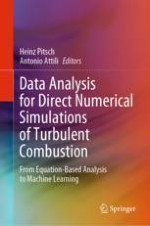2020 | OriginalPaper | Chapter
9. Physics-Informed Data-Driven Prediction of Turbulent Reacting Flows with Lyapunov Analysis and Sequential Data Assimilation
Authors : Luca Magri, Nguyen Anh Khoa Doan
Published in: Data Analysis for Direct Numerical Simulations of Turbulent Combustion
Publisher: Springer International Publishing
Activate our intelligent search to find suitable subject content or patents.
Select sections of text to find matching patents with Artificial Intelligence. powered by
Select sections of text to find additional relevant content using AI-assisted search. powered by
